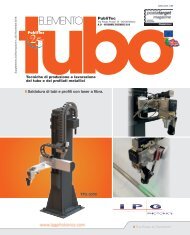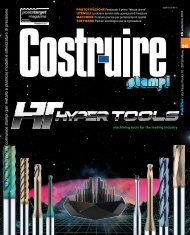Sfogliabile_A&L_n4_AGOSTO_2016
- No tags were found...
Create successful ePaper yourself
Turn your PDF publications into a flip-book with our unique Google optimized e-Paper software.
0007 1<br />
by Mario Conserva<br />
Editorial / Editoriale<br />
An absurd tariff for goods not produced in eu<br />
We are referring to the EU 3% import tariff on raw aluminium, which, in spite of<br />
the years that go by, globalization, weather changes, economic cycles and every<br />
other sort of event on the planet, keeps on weighing down the European aluminium<br />
industry. To this very day the raw metal identified and described as “aluminium,<br />
not alloyed, unwrought, code HS 760100”, which in 2007 was the subject of<br />
an autonomous reduction from 6% to 3% in customs tariffs, still retains a 3% EU<br />
import tariff, even though within the EU there are no producers supplying it to<br />
the market. It is evidently a blatant case of lack of logic.<br />
Many might remember the strenuous discussions that went on for years between<br />
primary aluminium producers in favour of protection and non integrated transformersandendusers,disadvantagedontheEUandglobalmarketsagainstcompetitors<br />
producing similar goods with lower costs.<br />
Itshouldbenotedthatinthislivelydebatebetweenthosewholoseandthose<br />
who gain there has always been a conflict of interest regarding credible data, until<br />
an independent and accurate report carried out by Rome’s LUISS University<br />
was published in 2015, showing the cost of the tariff to the aluminium downstream<br />
system to be up to 15 billion euro for the 2000-2013 period, a figure to be seriouslyponderedandonethatnobodyhasquestioned.<br />
During these past years many changes have impacted the EU aluminium industry.TheEUproductionofprimaryaluminiumbetween2002and2015decreasedfrom3.1Mtto2Mtwith38%lesssmeltersinoperation,moreoverofthe<br />
16 smelters still working all produce added value products only; no unalloyed<br />
760100 ingots are produced in the EU, approximately 2.5 million mt has to be<br />
importedandbecauseofthe3%importtariff,costtheEUconsumeraround<br />
125 million Euro’s in 2015 to the benefit of their non EU competitors. On the<br />
other hand, over the same period, the demand for alloyed and unalloyed primary<br />
aluminium in Europe grew at a rate of over 2.3% per year, reaching over 7<br />
million mt in 2015, showing ingot imports continually rising. We would therefore<br />
liketoconclude,forthosewhostilldonotwanttoseethingsastheyare,that<br />
the EU lacks metal, this scarcity increased extraordinarily<br />
during the past few years because producers<br />
totally or partially relocated smelters elsewhere,<br />
provingthatthesubsidyhiddenbythetariffserved<br />
nopurposeotherthancausingahefty15billioneuro<br />
worth of damages to the industry’s downstream, the<br />
most consistent part of the value chain both in terms<br />
of revenues as well as of the number of employees.<br />
Notwithstanding this, it is still hampered by a tariff that<br />
mario.conserva@edimet.com<br />
will continue to hinder the competitive strength of the<br />
EU downstream. The question therefore arises: why<br />
should we carry on damaging our industrial system with a tariff that does not<br />
protect, and why force consumers to pay to protect goods that are not even<br />
produced?Thecreativityofalobbydefendingitsprivilegemaybeunderstandable,<br />
but the system’s lack of action to cancel as soon as possible this absurd<br />
and unreasonable norm that protects the product known as “aluminium, not alloyed,<br />
unwrought code HS 760100”, that nobody in the EU produces, is culpable<br />
and irresponsible. The result is an extra cost of 15 billion euro for raw materials:<br />
is this the EU’s industrial policy?<br />
Un dazio assurdo per un bene non prodotto in ue<br />
Stiamo parlando del dazio UE sull’importazione di alluminio grezzo, un<br />
provvedimento che sfidando il tempo, la globalizzazione, i cambiamenti<br />
climatici, i cicli economici e così via, continua ad incombere sulla filiera europea<br />
dell’alluminio. Infatti a tutt’oggi il metallo grezzo non legato, identificato come<br />
“aluminium, not alloyed, unwrought, code HS 760100”, oggetto nel 2007 di<br />
una riduzione autonoma di tariffa daziaria, è ancora gravato di un dazio<br />
UE del 3% all’ importazione, anche se all’interno dell’Unione Europea non si<br />
trovano produttori che lo forniscano al mercato. E’ evidente che si tratta di<br />
un caso emblematico di illogicità. Molti ricorderanno le strenue discussioni<br />
che vanno avanti da anni tra i produttori di metallo favorevoli alla protezione<br />
ed i trasformatori non integrati e gli utilizzatori finali, penalizzati sul mercato<br />
globale rispetto a concorrenti di ogni parte del mondo che producono gli<br />
stessi beni spendendo meno. Va detto che in questo vivace dibattito tra chi<br />
guadagna e chi perde c’è sempre stato un gioco delle parti con pochi dati<br />
certi, sino a che non è stato pubblicato nel 2015 uno studio accurato condotto<br />
dall’Università LUISS di Roma, da cui emerge la valorizzazione oggettiva del<br />
costo del dazio per il sistema a valle del metallo, stimato in oltre 15 miliardi<br />
di euro per il periodo 2000-2013, una cifra importante e da far meditare<br />
seriamente e che nessuno ha messo in discussione.<br />
Nel corso degli ultimi anni molte cose sono cambiate nella filiera del metallo<br />
leggero, ci sono state mutazioni strutturali nelle grandi industrie storiche<br />
produttrici in particolare in Europa, dove la produzione di alluminio primario<br />
UE fra il 2002 e il 2015 è calata in modo significativo passando da 3,1 milioni<br />
a soli 2 milioni di tonnellate, con il 38% in meno di smelter in attività, e molti<br />
degli smelter ancora operativi sono a rischio chiusura o lavorano a regime<br />
ridotto. Inoltre mentre la domanda di alluminio primario in Europa è cresciuta<br />
di oltre il 2,3% all’anno, il metallo non legato 760100 nessuno lo produce in EU,<br />
ne debbono essere importati circa 2,3 milioni di t, con un extra costo a causa<br />
del dazio intorno a 125 milioni di euro nel 2015 sui consumatori e conseguente<br />
perdita di competitività. Concludiamo quindi, per chi non volesse ancora<br />
vedere come stanno le cose, ricordando che l’UE è deficitaria di metallo, il<br />
deficit è aumentato straordinariamente negli ultimi anni perché i produttori<br />
hanno delocalizzato in toto o in parte gli smelter, segno che il sussidio occulto<br />
del dazio non è servito a nulla se non a danneggiare pesantemente per oltre<br />
15 miliardi di euro il downstream della filiera, cioè la parte più consistente<br />
della catena di valore sia per fatturato che per numero di dipendenti; in<br />
più il tipo base di metallo, quello non legato, non viene neppure prodotto,<br />
salvo modestissimi quantitativi ad alta purezza, ma è comunque gravato di<br />
un dazio che aumenta la non competitività del downstream UE. E allora ci si<br />
domanda: perché continuare a danneggiare il nostro sistema industriale con<br />
una tariffa che non protegge, e perché costringere gli utilizzatori a pagare la<br />
protezione di un bene che non viene neppure prodotto? E’ forse comprensibile<br />
la creatività della lobby che difende un privilegio, è invece colpevole ed<br />
irresponsabile da parte del sistema non intervenire per cancellare al più presto<br />
un provvedimento assurdo ed irragionevole che protegge il bene “aluminium,<br />
not alloyed, unwrought code HS 760100” che non viene prodotto da nessuno<br />
in UE. Il risultato è un costo extra di 15 miliardi per la materia prima: è questa la<br />
politica industriale della Unione Europea?<br />
<strong>2016</strong> N° 04<br />
- 7




